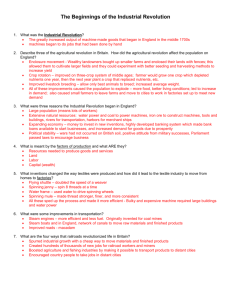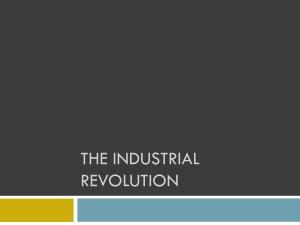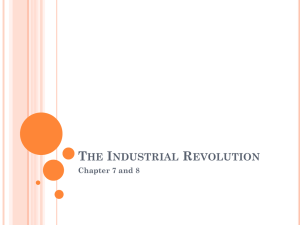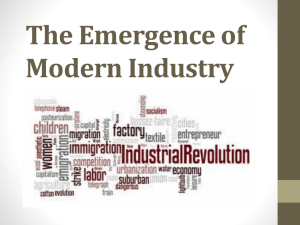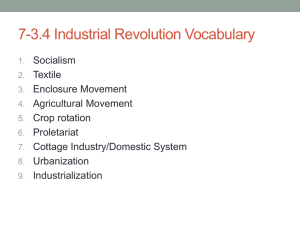Industrial Revolution
advertisement
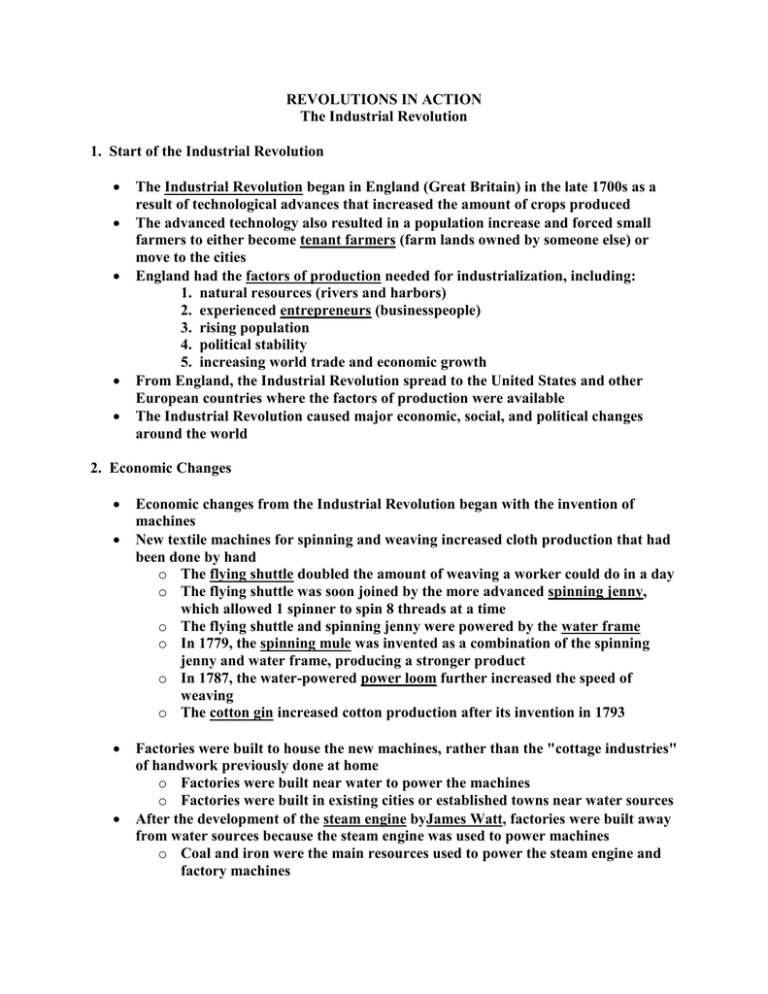
REVOLUTIONS IN ACTION The Industrial Revolution 1. Start of the Industrial Revolution The Industrial Revolution began in England (Great Britain) in the late 1700s as a result of technological advances that increased the amount of crops produced The advanced technology also resulted in a population increase and forced small farmers to either become tenant farmers (farm lands owned by someone else) or move to the cities England had the factors of production needed for industrialization, including: 1. natural resources (rivers and harbors) 2. experienced entrepreneurs (businesspeople) 3. rising population 4. political stability 5. increasing world trade and economic growth From England, the Industrial Revolution spread to the United States and other European countries where the factors of production were available The Industrial Revolution caused major economic, social, and political changes around the world 2. Economic Changes Economic changes from the Industrial Revolution began with the invention of machines New textile machines for spinning and weaving increased cloth production that had been done by hand o The flying shuttle doubled the amount of weaving a worker could do in a day o The flying shuttle was soon joined by the more advanced spinning jenny, which allowed 1 spinner to spin 8 threads at a time o The flying shuttle and spinning jenny were powered by the water frame o In 1779, the spinning mule was invented as a combination of the spinning jenny and water frame, producing a stronger product o In 1787, the water-powered power loom further increased the speed of weaving o The cotton gin increased cotton production after its invention in 1793 Factories were built to house the new machines, rather than the "cottage industries" of handwork previously done at home o Factories were built near water to power the machines o Factories were built in existing cities or established towns near water sources After the development of the steam engine byJames Watt, factories were built away from water sources because the steam engine was used to power machines o Coal and iron were the main resources used to power the steam engine and factory machines In the second wave of the Industrial Revolution in the 1870s, electricity, chemicals, and steel were the main sources for industrial business The steam engine also helped to improve transportation o The steam engine was used to power steamboats and locomotives, leading to the building of canals and railways for trade and transportation o The development of railroads created new jobs for railroad workers, and miners were needed to get coal to power the steam engine o Trade over longer distances grew and travel became easier The development of factories led to a division of labor as individuals were assigned specific tasks, which led to increased productivity and output of manufactured goods Interchangeable parts, where many identical parts were produced instead of the previous process of creating unique items by hand, made it easier to mass produce goods and repair them with machines Mass production also allowed goods to be produced at a cheaper price, making them more available to a higher portion of the population Workers spent as long as 14 hours a day, six days a week in the factories The working conditions were dangerous and resulted in injury without compensation from the companies Although conditions were dangerous, individuals could earn more in factories than on farms, leading to a large rural-to-urban migration 3. Social Changes Rural-to-urban migration led to many social changes The division of labor made clear the division between the workers and owners Many European cities doubled in population Low pay for workers and unhealthy environments in the cities made housing conditions very poor o The working class lived in crowded areas without basic needs such as running water o Conditions were unsanitary, and the factories produced pollution o Crime increased due to poverty and there was not enough police protection The middle and upper classes moved to nicer homes in the suburbs, which showed the growing class divisions 4. Political Changes Political changes came as a result of dangerous working conditions in the factories and the growing divisions between the different social classes Laissez-faire capitalism, an economic system in which all factors of production were owned by private individuals with no government interference, was the foundation of the Industrial Revolution o Capitalism allowed for divisions between those who had the wealth and those who did not Supporters of capitalism were against the creation of minimum wage laws and better working conditions, believing that it would upset the capitalist system and weaken the production of wealth The working class felt increasingly oppressed by the middle and upper classes, which led to rising support for socialism o Supporters of socialism believed that it would provide more for the working class people and allow the government to plan the economy to promote equality and end poverty o Socialism offered workers more protection than capitalism and it promised to distribute wealth according to need o Karl Marx and Friedrich Engels promoted radical socialism, stating that society was dividing into warring classes Marx and Engels believed that the proletariats (the "have-nots" or workers) would overthrow the bourgeoisie (the "haves" or the owners) and create a "dictatorship of the proletariat" The proletariat revolution did not occur during the Industrial Revolution, but Marx provided the inspiration for future reforms and revolutions Labor unions and reform laws came about in the 1800s to correct the issues between the social classes o Unions negotiated for better working conditions, higher pay, and shorter hours o Unions threatened to strike if demands were not met o The unions were restricted at first but achieved some success over time o In the 1830s, the British Parliament began regulating mine and factory conditions for women and children In addition to the wealth gap between rich and poor within industrialized nations, a global wealth gap was also occurring at this time As industrialized nations gained power over non-industrialized nations, the wealthier nations began to take advantage of the poorer nations for resources and markets Imperialism, a practice in which stronger nations dominated weaker nations, came from the Industrial Revolution

